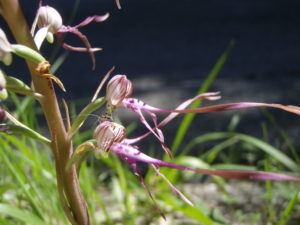Species and habitat description
The Himantoglossum adriaticum, common name Lizard Orchid is a spontaneous herbaceous species in Italy and belongs to the Orchidaceae family. Biological form: bulbose geophite. Plant whose perennial organ is a bulb from which, every year, flowers and leaves are born. The Lizard orchid reaches a height from 30 to 70 centimeters sometimes 1 meter. Basal elliptic-lanceolate leaves, up to 15 cm long, shorter caulines, sheathers. Inflorescence in a long multiflora cylindrical spike, with numerous zygomorphic, hermaphroditic, flowers, with linear bracts, longer than the ovary. The fruit is a fissuricidal capsule that contains many small seeds.
It lives in sunny and open spaces such as meadows, pastures, garrigues, road edges, preferably on a calcareous substrate, from 0 to 800 m of altitude.
Major threats
Loss of habitat and anthropic pressure included reforestation with allochthonous species, presence of invasive non-native/alien species and diseases and agriculture . Change in land use such as abandonment of grassland on slopes leads to succession and therefore competition for this orchid. A similar threat is posed by the introduction of invasive species, namely Robinia sp., that cause shading. Threats to the species itself are wild boars that eat the plants and collectors that pick it for ornamental use. Mining is a local threat in some areas. The species often grows on the edges of roads and the mowing of roadside quays are often a significant threat.
Himantoglossum adriaticum is a rare species that seems to increase in the area of Parco della Vena del Gesso.
In the region of Emilia Romagna it is a rare species and it is included in the list of Target Plant Species of Conservation Interest for the Emilia Romagna Region as DD (Data Deficient). It is included in the IUCN Red List of Threatened species of Italy as LC (Least concern).
Specific conservation action
Lizard orchid is present in the Apennines, included the IT4070011 site of the Park Vena del Gesso-Romagnola. In the area Specific conservation actions include harvesting and storing seeds in order to create a seed bank and preserve ecotypes. If necessary, resettlement of the species. Other actions consists in eliminating invasive alien species and in the maintenance of secondary prairies or in the opening glades to avoid the succession competition for this orchid. Census of nuclei along roads and issuing of direct protection regulations.

Related project areas
Carnè e Rontana
Bibliography
Dostalova, A., Montagnani, C., Hodálová, I., Jogan, N., Király, G., Ferakova, V. & Bernhardt, K.G. 2011. Himantoglossum adriaticum. The IUCN Red List of Threatened Species 2011: e.T162219A5559772. http://dx.doi.org/10.2305/IUCN.UK.2011-; www.actaplantarum.org ; http://ambiente.regione.emilia-romagna.it/it/parchi-natura2000/sistema-regionale/flora/flora-protetta; P. Lucci, S.Piastra Memorie del’Istituto Italiano di Speleologia Serie II vol. XXVIII-2015: I Gessi di Brisighella e Rontana, pp 299.